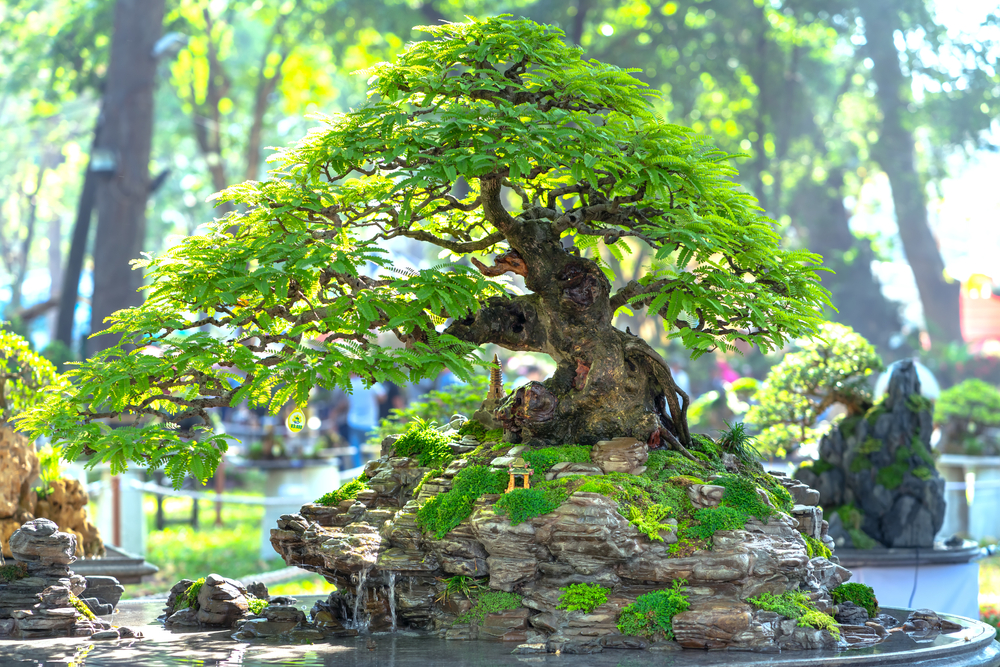
What is the Chinese Art of Penjing? (It’s Not the Same as Bonsai)
Penjing is an ancient Chinese art form of creating landscape scenes on a miniature scale. This art form is also known by the name penzai. The scenes feature living plants that artists and care-takers meticulously prune and cultivate to express emotion.
Penjing pieces can be whimsical, surreal scenes. Artists will include miniature figurines, such as a horse or person, communicating a dream-like narrative of natural elements.
Above all, the aim of this art form is to embody the principles that govern nature. Today we’ll explore the basics of this ancient art form and the various elements that define it as it exists in modernity.

History of Penjing
Dating all the way back to the 1st Century AD (and perhaps even earlier), practitioners of Daoist mysticism have endeavored to create landscape scenes in miniature. People see it as a means to focus on and increase the properties we might experience at full-size sights.
In the art form’s earliest versions, it was said to be a legendary power to shrink entire landscapes down to the size of a wide pot. Buddhist monks from China brought the art form to Japan. Members of the aristocracy and even samurai practiced it. Today, students often study for ten or more years to gain sufficient skills in the craft.
In Chinese, “pen” means pot, and “jing” is translated to landscape or scenery. When done well, these art pieces are living odes to nature that convey a reverence and appreciation of the natural world that is deeply embedded in Chinese traditional culture.
Penjing is an artistic style that emulates a wild, natural aesthetic. Plantlife is on display in a controlled landscape form.
Contrarily, bonsai is a more refined, controlled style of depicting nature initially inspired by the Chinese practice of Penjing. Miniature landscapes are a popular art form around the world today, delighting and enthralling children, botanists, and art collectors alike.
Styles of Penjing
China is big. With that scale comes regional personality and difference. The art of penjing reflects these distinctions, with particular styles of penjing differentiated between geographical and cultural locations.
This includes Lingnan style, Taiwan style, Shanghai style, and Yangzhou style, for instance. Experts in the art form consider there to be three main categories within these geographical categories.
Shumu – 樹木盆景
The Shumu style is a landscape of trees, which artists plant within a container. Penjing experts define this style through the use of trimming, pruning, and wiring the landscape into a cultivated vision. This style is very similar to the bonsai traditions of Japan.

Shanshui – 山水盆景
Shanshui penjing style is a landscape that features a rock inside a tray of water. Artists carefully select and place stones in the water. Often, artists incorporate small living plants into the composition as well.

Shuihan – 水旱盆景
Shuihan style landscapes are miniature creations that might contain trees, rocks, water, and additional tiny figurines of houses, animals, and people. Artists combine the previous two styles to create Shuihan landscapes. As a result, these detailed landscapes communicate an abstract narrative.

An Evolving Artform
Part of the beauty of penjing as an art form is that it is a fluid and evolving form of expression due to the ways particular artists will experiment.
The style and the content of the artform are increasingly varied according to penjing artist Zhao Quingquan. Regardless of how the art form changes in technical definition, the art aims at “seeing the big from the tiny” and conveying universal emotions.

How To Practice Penjing At Home
Ten years of intensive study at a botanical garden in Shanghai might not be a realistic endeavor for most of us. Luckily, that doesn’t mean that the gorgeous, peaceful aesthetics of this art form can’t be appreciated in your own home or garden.
Finding a shallow pot with drainage is a critical place to start. For almost all miniature landscapes, you are going to need access to bright light and consistent, temperate temperatures. These are the easy steps.
Next up? Research – lots and lots of research, but this can be a highlight of the process. For example, you can dream up the scene you want to emulate or pay homage to, and then work to collaborate with the plants you grow to make it real.
There’s a booming bonsai industry in the western world with best-selling books and Pinterest boards to get ideas. Often, local garden shops will sell miniature-friendly varieties of plants, rocks, and moss to buy and use. The endless information of the internet is at your fingertips.
Most importantly, a stubborn combination of curiosity and patient experimentation will be your most important guides in cultivating these miniature scenes of striking beauty into your own life.


